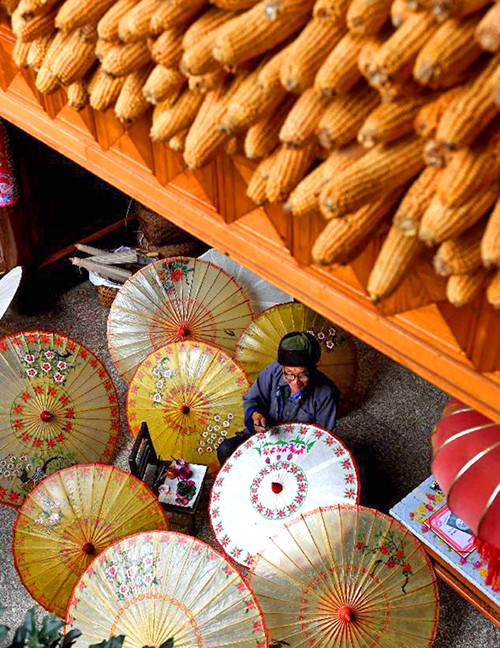Time-honored craft of making oiled-paper umbrellas embodies China’s poetic legacy
Author : Liu Xueyi Source : Chinese Social Sciences Today 2016-08-11

The traditional manufacturing skills used in oiled-paper umbrellas have been recognized by experts as being a living relic of the Chinese umbrella folk art.
China’s long history of oiled-paper umbrella craftsmanship is rich with cultural significance.
In ancient times, oiled-paper umbrellas found their way to Japan, Korea, Vietnam and other Asian countries via merchants and envoys, often taking on new characteristics along the way.
Oiled-paper umbrellas are not only used for everyday tasks like protecting people from sunshine and rain, they are also an indispensable item in some wedding traditions, as they are said to bring peace and good fortune.
In some traditional Chinese weddings, the matchmaker uses a red oiled-paper umbrella to cover the bride as she disembarks from a sedan, which symbolizes the way in which she is protected from evil. In some traditional Japanese weddings, the bride is covered by a red oiled-paper umbrella as well. They are also important stage props in traditional Japanese dancing performances.
In Chinese ritual ceremonies, an open oiled-paper umbrella is tied on the top of the “deity sedan” as a symbol of expelling evils and being safe from extreme weather. This is because the umbrella symbolizes completeness, perfection and satisfactory conclusions.
In 2008, the Fengshui oiled-paper umbrellas of Luzhou, Sichuan Province, were classified as national intangible cultural heritage. The Fengshui oiled-paper umbrella’s ribs are made of bamboo at least three years of age.
The covers of these umbrellas are made of manual cotton paper, with stunning lithographic designs that represent traditional Chinese culture, which are painted with eco-friendly tung oil.
The traditional manufacturing skills used have been recognized by experts as being a living relic of the Chinese umbrella folk art. In 2009, the sixth generation successor of Fengshui oiled-paper umbrellas, Bi Liufu, was listed as a representative successor of this national intangible cultural heritage project by the Ministry of Culture. Bi became the sole representative successor of hand-made oiled-paper umbrellas to be authorized by the Chinese government.
Oiled-paper umbrellas have been used in China for more than 1,000 years. It is widely acknowledged that the oiled-paper umbrella was the first type of umbrella in the world. They are hand-made, and created from natural, eco-friendly materials.
In the Hakka dialect, the pronunciation of “oiled-paper” sounds like “having a son.” So when a Hakka woman gets married, the bride’s family usually adds two oiled-paper umbrellas to the dowry as a form of blessing, which means: “may you soon have a son.”
The structure of the traditional Chinese character for “umbrella” is composed of the five characters of “man,” which represents fertility and having many descendants. The cover of an open oiled-paper umbrella is like a circle, which symbolizes good fortune and longevity.
In the past, parents often gave an oiled-paper umbrella to their son when he turned 16, as a way of expressing the hope that he can take responsibility for supporting the family.
The earliest recorded umbrella was created by the sister of Lu Ban (507-444 BCD), an outstanding inventor, architect and carpenter during the Spring and Autumn, and the Warring States period.
Because Lu often worked outdoors and got wet on rainy days, his sister wanted to make a tool to protect her brother from the rain. She chopped the bamboo into strips to make the rack, and placed a piece of animal leather on the strips. When it was folded, it looked like a stick. When it was open, it looked like the top of a pavilion. This was the earliest form of the umbrella. After Cai Lun (?-121) invented paper in the Eastern Han Dynasty, it was used to create umbrellas with a layer of tung oil to make them waterproof.
Some literati and scholars inscribe poems or draw paintings on the umbrellas, generally to express their thoughts on nature.
Ye Shengtao made Chinese fairy tales from a wilderness
Ye Shengtao (1894–1988) created the first collection of fairy tales in the history of Chinese children’s literature...
-
How northern ethnicities integrated into Chinese nation
2023-09-18
-
Mogao caves
2023-09-12
-
Mogao Grottoes as ‘a place of pilgrimage’
2023-09-12
-
Time-honored architectural traditions in China
2023-08-29
-
Disentangling the civilizational evolution of China
2023-08-28
-
AI ethics in science fiction
2023-08-23














 2011-2013 by www.cssn.cn. All Rights Reserved
2011-2013 by www.cssn.cn. All Rights Reserved